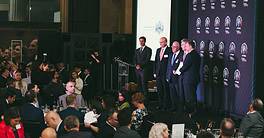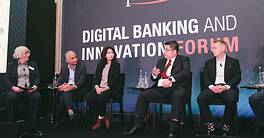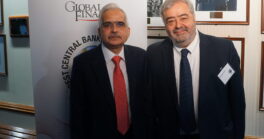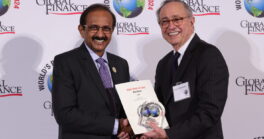South Korea still leads among emerging-market banks, while some Gulf entities are rising in the ranks.
South Korean banks take the top three places in Global Finance magazine’s ranking of the world’s safest emerging-market banks. Korea Development Bank and Export-Import Bank of Korea lead the list, with two AA ratings and one of AA-. Industrial Bank of Korea follows with one AA rating and two of AA-.
In fourth place is First Abu Dhabi Bank, the product of the merger earlier this year of National Bank of Abu Dhabi (NBAD) and First Gulf Bank. All three rating agencies transferred their ratings on NBAD to the new institution, enabling it to retain the place it held last year.
These four banks are the only emerging-market banks to have three ratings in the AA range. A score of 13 points, the minimum level for inclusion this year, requires two ratings of A- and one of A, or an equivalent configuration.
There are three new entrants in this year’s Emerging Markets ranking. eská Spoitelna from the Czech Republic enters in 42nd place following an upgrade from S&P; and South Korea’s Suhyup Bank enters in 45th place, also through an S&P upgrade. Kuwait’s Boubyan Bank enters the rankings at 49th, following an upgrade by Moody’s.
Making room for these three were First Gulf Bank, which dropped out of the rankings after its merger with NBAD; and two Saudi banks, Al-Rajhi and Samba Financial Group. Both the Saudi banks scored the same as 50th-placed National Commercial Bank (also from Saudi Arabia), but are ranked lower due to their smaller asset size.
In line with the methodology used for the Global Top 50 list, banks that score the same are ranked by order of asset size, reflecting the strong positive correlation between asset size and high ratings. Qatar Islamic Bank moves up an impressive 22 places to 25th this year after receiving a first-time rating of A1 from Moody’s. KEB Hana moves up 13 places, to 22nd, following an upgrade from S&P.
Several large Chinese banks were downgraded by Moody’s following its downgrade of the Chinese government in May, but the broader story in this year’s Emerging Markets rankings is one of upgrades. This contrasts with the broad trend in the Global 50 Safest Banks ranking, where movement was prompted primarily by downgrades.
Banks from the GCC states contribute 23 of the 50 safest emerging-market banks this year, while banks in Asia contribute 21. Chile contributes four and the Czech Republic two.
Within the GCC, Qatar provides nine banks, Kuwait seven, the UAE six and Saudi Arabia one. Bank ratings are heavily influenced by their government’s ratings. With all three agencies signaling downward pressure on their ratings of the Qatari government as a result of the diplomatic dispute with its neighbors, Qatari banks may find themselves being downgraded.
No Middle Eastern country apart from these four Gulf states has banks that come close to scoring highly enough to rank among the safest 50 emerging-market banks. Banks in Oman used to enjoy mid-range investment-grade ratings, but a series of downgrades over the last two years has now put inclusion well beyond their reach.
South Korea contributes nine banks to the top 50, one more than last year. China contributes eight and Taiwan four.
Banks from many of the world’s largest emerging-market banking systems—Brazil, Turkey, Russia, India and South Africa—still fall far short of scoring highly enough to make the Global Top 50. The strongest Mexican banks are not far off, but would need at least a one notch upgrade from each of the three agencies to stand a chance of inclusion.
Similarly, in Central and Eastern Europe and the former Soviet Union, only Polish banks are in the running; other banking systems trail far behind. In sub-Saharan Africa, only South African banks are on terms with investment-grade ratings. Other banks in the region are rated deep in speculative-grade territory.
|
THE 50 SAFEST EMERGING MARKETS BANKS | ||||||||
|---|---|---|---|---|---|---|---|---|
|
Rank |
Group Name |
Country |
Ratings |
Total Score |
Assets $ mn |
Statement Date | ||
|
Fitch |
Moody’s |
S&P | ||||||
|
1 |
Korea Development Bank |
South Korea |
AA- |
Aa2 |
AA |
23 |
225,766 |
12/31/16 |
|
2 |
Export-Import Bank of Korea |
South Korea |
AA- |
Aa2 |
AA |
23 |
74,820 |
12/31/16 |
|
3 |
Industrial Bank of Korea |
South Korea |
AA- |
Aa2 |
AA- |
22 |
212,537 |
12/31/16 |
|
4 |
First Abu Dhabi Bank |
UAE |
AA- |
Aa3 |
AA- |
21 |
185,799 |
12/31/16 |
|
5 |
National Bank of Kuwait |
Kuwait |
AA- |
Aa3 |
A+ |
20 |
79,073 |
12/31/16 |
|
6 |
China Development Bank |
China |
A+ |
A1 |
AA- |
19 |
1,943,930 |
12/31/16 |
|
7 |
Agricultural Development Bank of China |
China |
A+ |
A1 |
AA- |
19 |
644,401 |
12/31/16 |
|
8 |
Export-Import Bank of China |
China |
A+ |
A1 |
AA- |
19 |
479,776 |
12/31/16 |
|
9 |
Qatar National Bank |
Qatar |
AA- |
Aa3 |
A |
19 |
197,718 |
12/31/16 |
|
10 |
Banco del Estado de Chile |
Chile |
A+ |
Aa3 |
A+ |
19 |
52,133 |
12/31/16 |
|
11 |
Bank of Taiwan |
Taiwan |
N/R |
Aa3 |
A+ |
18.5 |
154,362 |
9/30/16 |
|
12 |
Shinhan Bank |
South Korea |
A |
Aa3 |
A+ |
18 |
250,604 |
12/31/16 |
|
13 |
Banco Santander Chile |
Chile |
A+ |
Aa3 |
A |
18 |
55,493 |
12/31/16 |
|
14 |
Kookmin Bank |
South Korea |
A |
A1 |
A+ |
17 |
254,089 |
12/31/16 |
|
15 |
Abu Dhabi Commercial Bank |
UAE |
A+ |
A1 |
A |
17 |
70,331 |
12/31/16 |
|
16 |
Banco de Chile |
Chile |
N/R |
Aa3 |
A |
17 |
47,117 |
12/31/16 |
|
17 |
Union National Bank |
UAE |
A+ |
A1 |
N/R |
17 |
28,296 |
12/31/16 |
|
18 |
Al Hilal Bank |
UAE |
A+ |
A1 |
N/R |
17 |
11,825 |
12/31/16 |
|
19 |
Industrial and Commercial Bank of China |
China |
A |
A1 |
A |
16 |
3,473,088 |
12/31/16 |
|
20 |
China Construction Bank |
China |
A |
A1 |
A |
16 |
3,016,447 |
12/31/16 |
|
21 |
Bank of China |
China |
A |
A1 |
A |
16 |
2,611,426 |
12/31/16 |
|
22 |
KEB Hana Bank |
South Korea |
A- |
A1 |
A+ |
16 |
257,165 |
12/31/16 |
|
23 |
NongHyup Bank |
South Korea |
A- |
A1 |
A+ |
16 |
207,561 |
12/31/16 |
|
24 |
Kuwait Finance House |
Kuwait |
A+ |
A1 |
A- |
16 |
53,902 |
12/31/16 |
|
25 |
Qatar Islamic Bank |
Qatar |
A+ |
A1 |
A- |
16 |
38,416 |
12/31/16 |
|
26 |
Mega International Commercial Bank |
Taiwan |
N/R |
A1 |
A |
15.5 |
93,251 |
9/30/16 |
|
27 |
Land Bank of Taiwan |
Taiwan |
N/R |
Aa3 |
A- |
15.5 |
79,819 |
6/30/16 |
|
28 |
Abu Dhabi Islamic Bank |
UAE |
A+ |
A2 |
N/R |
15.5 |
33,299 |
12/31/16 |
|
29 |
Al Ahli Bank of Kuwait |
Kuwait |
A+ |
A2 |
N/R |
15.5 |
13,998 |
12/31/16 |
|
30 |
Barwa Bank |
Qatar |
A+ |
A2 |
N/R |
15.5 |
12,651 |
12/31/16 |
|
31 |
Ahli United Bank (Kuwait) |
Kuwait |
A+ |
A2 |
N/R |
15.5 |
12,062 |
12/31/16 |
|
32 |
Qatar International Islamic Bank |
Qatar |
A+ |
A2 |
N/R |
15.5 |
11,690 |
12/31/16 |
|
33 |
Ahli Bank |
Qatar |
A+ |
A2 |
N/R |
15.5 |
10,485 |
12/31/16 |
|
34 |
International Bank of Qatar |
Qatar |
A+ |
A2 |
N/R |
15.5 |
9,824 |
12/31/16 |
|
35 |
Agricultural Bank of China |
China |
A |
A2 |
A |
15 |
2,815,917 |
12/31/16 |
|
36 |
CTBC |
Taiwan |
A |
A2 |
A |
15 |
109,132 |
12/31/16 |
|
37 |
Banco de Crédito e Inversiones |
Chile |
A- |
A1 |
A |
15 |
46,232 |
12/31/16 |
|
38 |
Doha Bank |
Qatar |
A+ |
A2 |
A- |
15 |
24,826 |
12/31/16 |
|
39 |
Bank of Communications |
China |
A |
A2 |
A- |
14 |
1,209,123 |
12/31/16 |
|
40 |
Woori Bank |
South Korea |
A- |
A2 |
A |
14 |
257,081 |
12/31/16 |
|
41 |
Emirates NBD |
UAE |
A+ |
A3 |
N/R |
14 |
121,989 |
12/31/16 |
|
42 |
eská Spoitelna |
Czech Republic |
A- |
A2 |
A |
14 |
41,598 |
12/31/16 |
|
43 |
Komerní banka |
Czech Republic |
A- |
A2 |
A |
14 |
35,990 |
12/31/16 |
|
44 |
Commercial Bank of Qatar |
Qatar |
A+ |
A2 |
BBB+ |
14 |
35,819 |
12/31/16 |
|
45 |
Suhyup Bank |
South Korea |
N/A |
A2 |
A |
14 |
23,950 |
6/30/16 |
|
46 |
Gulf Bank |
Kuwait |
A+ |
A3 |
A- |
14 |
17,861 |
12/31/16 |
|
47 |
Al Khalij Commercial Bank (al khaliji) |
Qatar |
A+ |
A3 |
N/R |
14 |
16,648 |
12/31/16 |
|
48 |
Commercial Bank of Kuwait |
Kuwait |
A+ |
A3 |
N/R |
14 |
13,477 |
12/31/16 |
|
49 |
Boubyan Bank |
Kuwait |
A+ |
A3 |
N/R |
14 |
11,375 |
12/31/16 |
|
50 |
National Commercial Bank |
Saudi Arabia |
A- |
A1 |
BBB+ |
13 |
117,731 |
12/31/16 |
Note: Ratings valid on July 31, 2017



